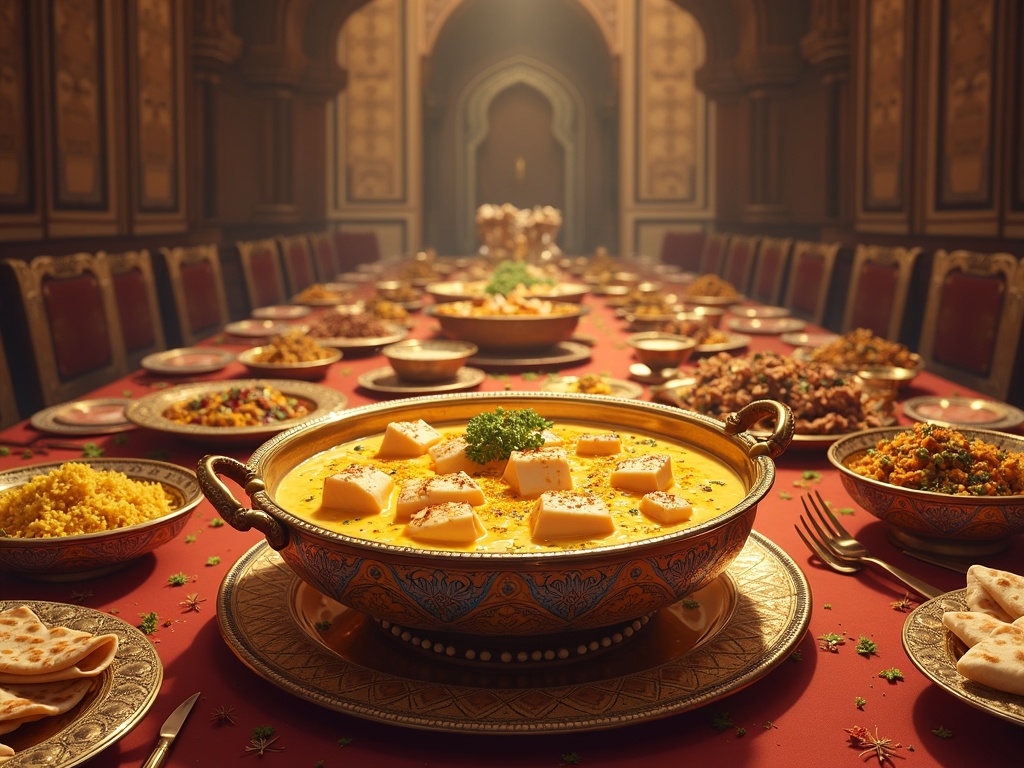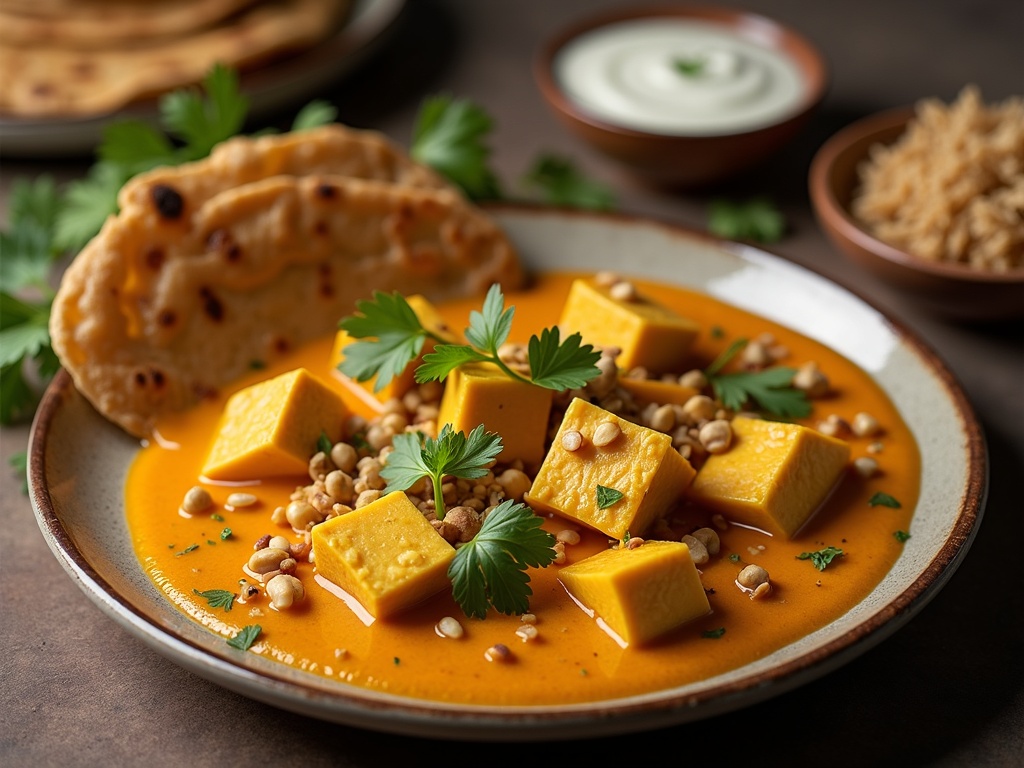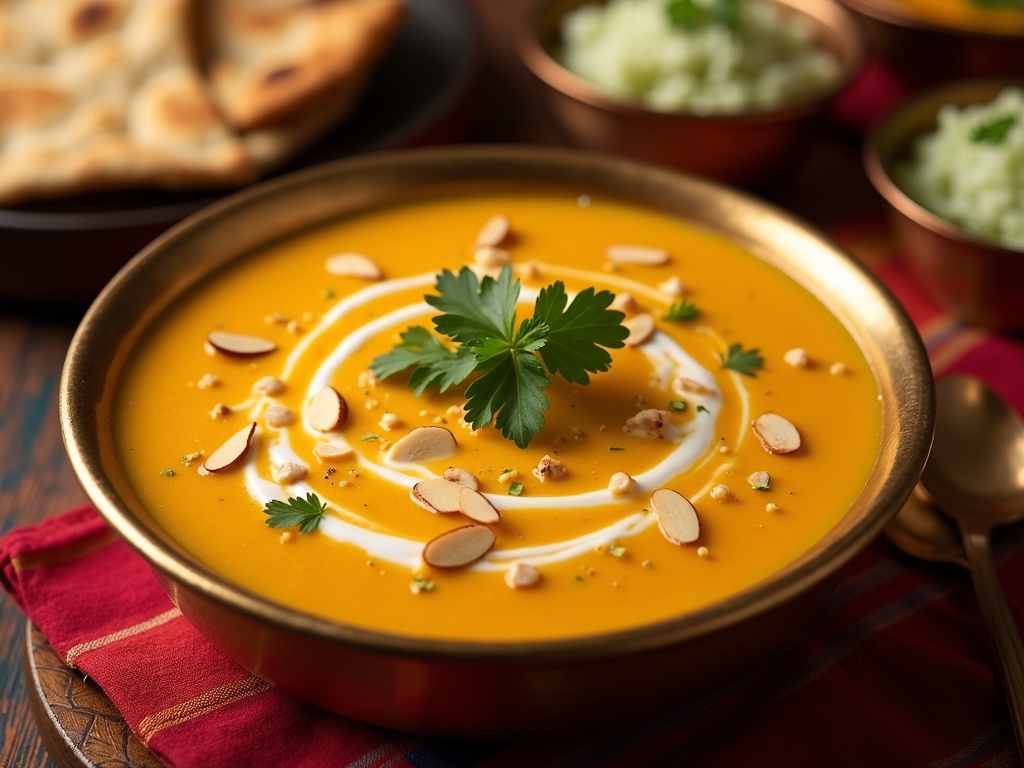Shahi paneer recipe, meaning “royal cheese,” dates back to the grand Mughal era where it was prepared in imperial kitchens to dazzle emperors with its harmony of flavor, texture, and presentation. This cherished dish showcases the blend of Persian cooking techniques with Indian ingredients, featuring tender paneer cubes in a smooth sauce crafted from ground nuts, fragrant spices, and premium dairy elements for an indulgent meal.
Find In This Article
Key Takeaways
- The dish features fresh paneer cubes in a silky gravy made from cashews and almonds, creating its signature royal texture and flavor profile.
- Essential ingredients include heavy cream, yogurt, aromatic spices like cardamom and garam masala, and ghee for authentic taste.
- Traditional preparation involves soaking and blending nuts, caramelizing onions, and gently simmering paneer in the creamy gravy to perfection.
- Shahi paneer pairs beautifully with naan, butter roti, or jeera rice, and can be elegantly garnished with fresh cream, slivered nuts, and coriander leaves.
- Despite its rich taste, shahi paneer offers nutritional benefits with approximately 20g of protein per serving and essential amino acids from paneer.
The Royal Origins of This Beloved Dish
I can trace shahi paneer’s impressive lineage directly to India’s royal past. The very name ‘shahi’ translates to ‘royal’ in Hindi, immediately hinting at its noble heritage and distinguished status in Indian cuisine. This isn’t just another curry—it’s a dish with regal pedigree.
From Mughal Kitchens to Modern Tables
The creation of shahi paneer dates back to the opulent Mughal era, when royal khansamas (chefs) crafted dishes to impress emperors and their courtiers. The Mughal rulers, known for their refined palates, demanded extraordinary culinary creations that balanced flavor, texture, and presentation. Shahi paneer emerged from these royal kitchens as a perfect representation of Mughal culinary artistry, combining local Indian ingredients with cooking techniques favored by the nobility.
The dish exemplifies the fusion of Persian influence with Indian ingredients—a hallmark of Mughal cuisine. I’ve found that this historical blend created something truly special: a dish where paneer (Indian cottage cheese) becomes transformed through its marriage with luxurious ingredients like cashews, almonds, and aromatic spices.
A Celebration of Rich Ingredients
Shahi paneer brings together several key elements that make it worthy of its royal title:
- Soft, fresh paneer cubes that absorb the flavors of the gravy
- A velvety sauce made from ground nuts like cashews and almonds
- Aromatic spices including cardamom, cinnamon, and cloves
- Rich dairy components such as cream, milk, or yogurt
- Delicate flavoring from saffron, the world’s most expensive spice
This combination creates the signature creamy texture and complex flavor profile that distinguishes shahi paneer from simpler paneer dishes like paneer masala. The ground nuts provide both richness and thickness to the gravy, while the dairy elements add a silky finish that coats each piece of paneer perfectly.
Today, shahi paneer remains a fixture at weddings, Diwali celebrations, and special family gatherings across India. Its status as celebration food persists because it delivers something everyday dishes cannot—a taste of luxury and heritage in every bite. The dish’s enduring popularity across generations speaks to how successfully it balances indulgence with comfort, making royal cuisine accessible to everyone’s table.

Essential Ingredients That Create the Magic
Core Components
Fresh paneer forms the foundation of this royal dish. I recommend using 400g of high-quality paneer, preferably homemade for that melt-in-your-mouth texture. Store-bought works too, but fresh varieties deliver superior results compared to frozen alternatives.
The rich, creamy gravy requires 50g each of cashews and almonds, which create that signature silky texture. These nuts add both body and flavor to the sauce, giving it that distinctive royal character.
Spices play a crucial role in developing authentic flavor. You’ll need 1 teaspoon each of aromatic cumin seeds, warming garam masala, and vibrant turmeric powder. These create the perfect flavor foundation without overwhelming the delicate dairy components.
For that luxurious mouthfeel, 200ml of heavy cream and 100g of yogurt are essential. The cream adds richness while yogurt brings a subtle tang that balances the dish. I always make sure to use full-fat versions of both for the most indulgent results.
Flavor Enhancers
Two tablespoons of ghee (clarified butter) add a nutty depth that’s impossible to replicate with regular oils. This traditional cooking fat carries flavors beautifully and contributes to the authentic taste profile.
For those who enjoy a hint of heat, green chilies can be added according to your spice preference. I find that 1-2 finely chopped chilies provide just enough warmth without overpowering the creamy elements.
A small amount of sugar (about half a teaspoon) can help balance the flavors, especially if your tomatoes are particularly acidic. This subtle addition won’t make the dish sweet but will round out the flavor profile beautifully.
The quality of ingredients makes a significant difference in shahi paneer. Fresh ingredients consistently outperform frozen alternatives in both texture and flavor. If you’re looking for inspiration for other paneer dishes, you might want to check out this delicious paneer masala recipe which uses many similar ingredients.
Remember, shahi paneer is a celebration of dairy, so don’t compromise on the quality of your paneer, cream, or yogurt. These elements carry the dish and create that memorable, velvety texture that makes everyone ask for seconds.
Creating the Perfect Shahi Paneer
I start my Shahi Paneer preparation by soaking cashews and almonds in warm water for at least 30 minutes. This softening process makes them blend smoothly later, creating that signature creamy texture that defines this royal dish.
The cooking begins with heating a tablespoon of ghee in a deep pan. Once it’s hot, I add cumin seeds and wait for that magical crackling sound that releases their aromatic oils. This fragrant base will infuse the entire dish with warmth.
Next, I add finely chopped onions to the pan. Patience is key here – I cook them slowly until they reach a beautiful golden-brown color, which usually takes about 8-10 minutes. This caramelization creates depth of flavor that can’t be rushed.
Building Layers of Flavor
Once my onions have caramelized, I stir in a tablespoon of ginger-garlic paste, cooking it until the raw smell disappears – typically just a minute or two. The fragrance that fills the kitchen at this point is incredible!
The next crucial step involves adding chopped tomatoes. I cook them down until they break apart and form a thick gravy base. This might take 6-8 minutes of gentle simmering, during which I occasionally stir to prevent sticking.
While the tomatoes cook down, I drain and blend the soaked nuts into a smooth paste. This creamy mixture gets stirred into the gravy, instantly transforming its texture and color to a richer, more luxurious consistency.
The real magic happens when I add yogurt and cream. I do this gradually, stirring continuously to prevent curdling. The gravy now takes on that signature shahi (royal) quality – velvety smooth with a subtle tang from the yogurt balanced by the richness of cream.
Final Touches for Perfection
Seasoning is critical for authentic flavor. I add salt, a pinch of sugar to balance acidity, garam masala, and a touch of red chili powder. The gravy needs to simmer for 10-15 minutes to allow these flavors to meld together beautifully.
Only then do I gently slide in the paneer cubes. I prefer to use fresh paneer when possible, as it absorbs flavors better than the firmer store-bought varieties. The paneer simmers in the gravy for about 5 minutes – just long enough to warm through without becoming tough.
For the finishing touch, I sprinkle freshly chopped coriander leaves or crushed kasuri methi (dried fenugreek leaves). This final garnish adds a fresh, aromatic element that elevates the entire dish.
The result is a Shahi Paneer that’s fit for royalty – creamy, aromatic, and complex in flavor. It pairs perfectly with naan, roti, or jeera rice. For more Indian paneer inspiration, you might want to try making a delicious Paneer Masala next time.
Remember that Shahi Paneer tastes even better the next day after the flavors have had more time to develop. I often make a larger batch specifically to enjoy leftovers for lunch. The key to its distinctive taste is balancing the richness of the nuts and cream with the tang of yogurt and the warmth of spices.
Perfect Pairings and Presentation
Shahi paneer achieves its full potential when paired with the right accompaniments and presented with flair. I’ve found that the rich, creamy texture of this royal dish demands thoughtful companions that complement rather than compete with its distinctive flavor profile.
Bread and Rice Companions
The velvety gravy of shahi paneer pairs beautifully with various Indian breads that help soak up every last bit of the delicious sauce. Here are some ideal options to serve alongside your creation:
- Naan bread: Its soft, slightly chewy texture makes it perfect for scooping up the creamy gravy.
- Butter roti: The simplicity of this flatbread lets the complex flavors of shahi paneer shine.
- Garlic naan: Adds a complementary flavor dimension that enhances the dish.
- Jeera rice: The aromatic cumin-infused rice provides a subtle backdrop that balances the rich gravy.
- Steamed basmati rice: Its fragrance and fluffy texture make it a classic pairing option.
For a complete meal experience, I recommend serving a small bowl of cucumber raita on the side. This cool yogurt-based condiment offers a refreshing contrast to the rich, spiced gravy of the shahi paneer recipe, cleansing the palate between bites.
Presentation and Garnishing
The visual appeal of shahi paneer can be elevated with thoughtful garnishing that also enhances its flavor profile:
- Finish with a light drizzle of fresh cream in a circular pattern.
- Sprinkle slivered almonds or cashews for added texture and visual appeal.
- Add a few fresh coriander leaves for a pop of color.
- Include a small pat of butter on top for added richness.
- Dust with a pinch of garam masala for aromatic appeal.
For special gatherings, I like to serve shahi paneer in traditional copper or brass serving bowls that highlight its royal heritage. This presentation instantly elevates the dining experience and pays homage to the dish’s origins in royal kitchens.
A tangy side salad with sliced onions, tomatoes, cucumbers, and a squeeze of lemon juice provides a perfect counterpoint to cut through the richness of the dish. The contrast in temperatures, textures, and flavors creates a balanced meal that satisfies on multiple levels.
What Makes It Healthy
Shahi paneer offers a fantastic balance of nutrients, making it a healthy addition to your meal rotation. I’ve found that a typical 200g serving contains approximately 400 calories, which fits well into a balanced diet when paired with appropriate sides.
Nutritional Breakdown
This creamy dish provides about 25g of fat, 20g of protein, and 20g of carbohydrates per serving. The star ingredient, paneer, is exceptionally rich in calcium, which supports bone health and muscle function. I appreciate how paneer provides a complete protein source for vegetarians, containing all essential amino acids your body needs.
The healthy fats in shahi paneer come from two main sources – the nuts used in the gravy and the cream that gives it that signature richness. These fats help with vitamin absorption and provide sustained energy. Unlike processed foods with unhealthy trans fats, the fats in this dish are primarily unsaturated and saturated fats from natural sources.
As a protein-rich main course option, shahi paneer helps:
- Build and repair muscles
- Keep you feeling full longer
- Stabilize blood sugar levels
- Support immune function
I find that pairing shahi paneer with whole grain roti or brown rice creates a complete meal that’s satisfying while still being nutritious. For an even healthier twist, you can adjust the cream quantity or substitute with yogurt in some paneer masala variations without sacrificing too much of that royal flavor.
The combination of protein from paneer, complex carbohydrates from the gravy, and healthy fats creates a dish that not only tastes indulgent but also provides sustained energy and essential nutrients.

Sources:
The Joy of Indian Cooking – by Anjali Pathak, 2017
Indian Cuisine: A Historical and Cultural Perspective – by Jaya Dutt, 2020
Nutrition Facts of Paneer and Its Benefits – Health Journal, 2022

